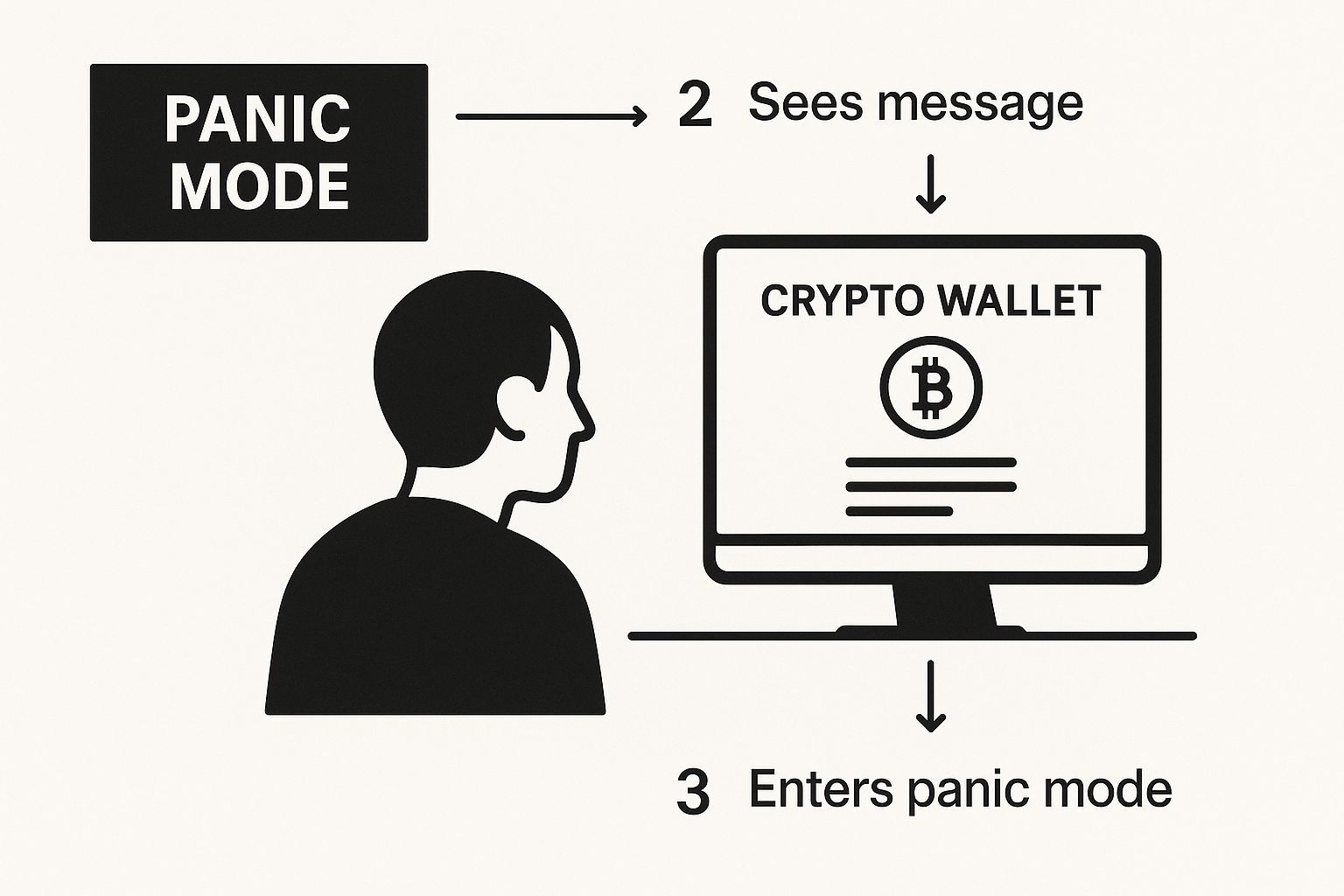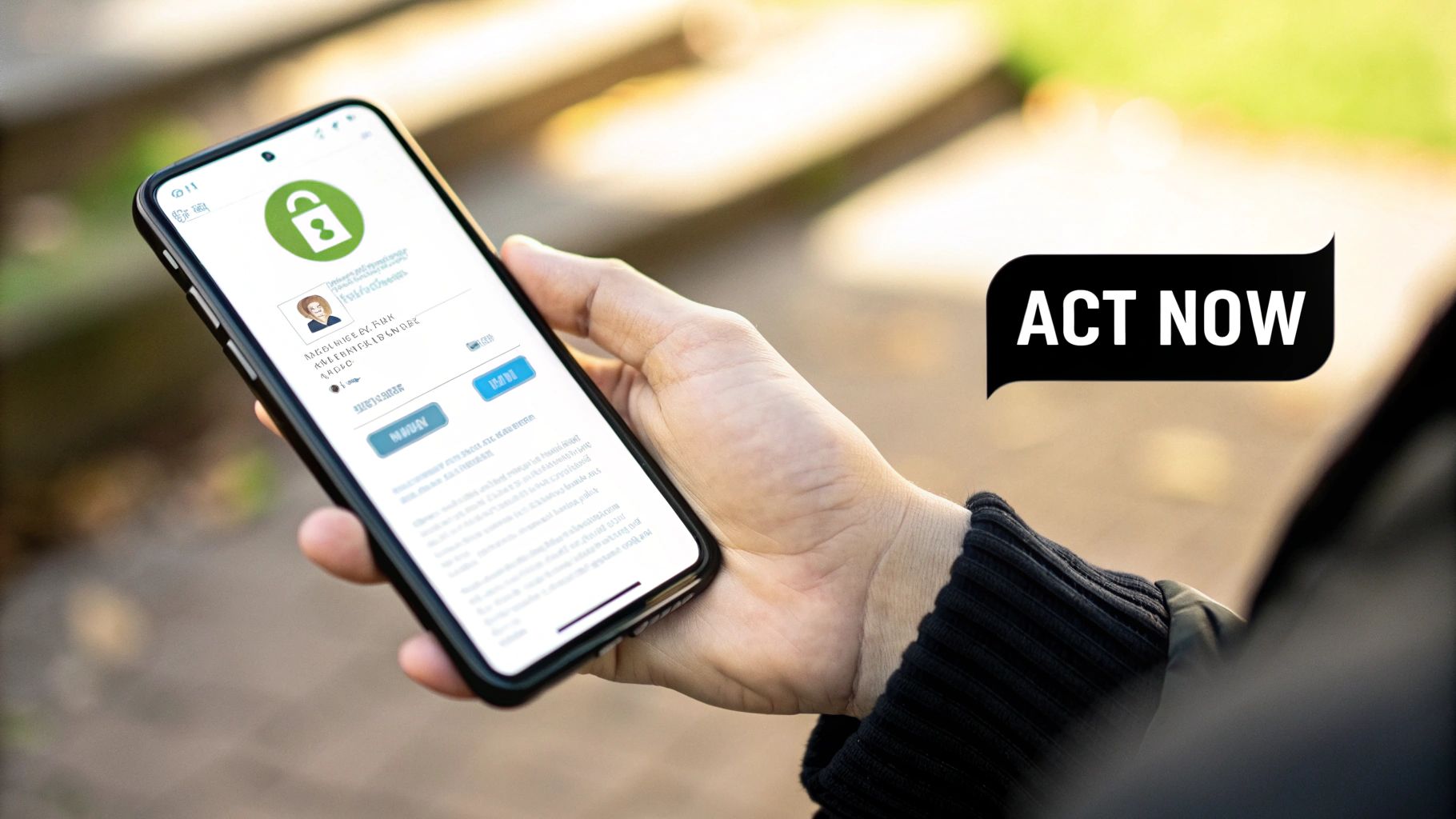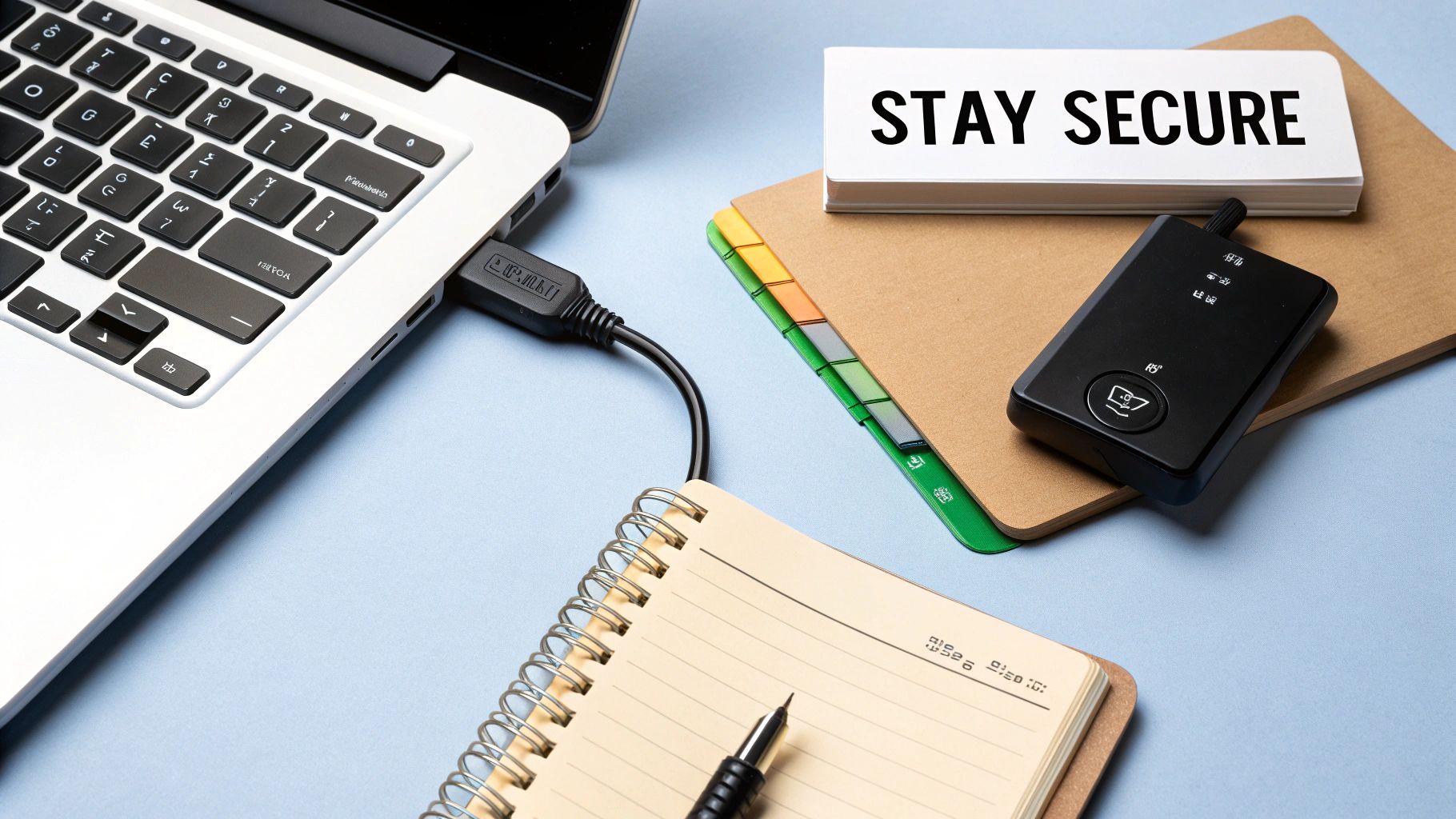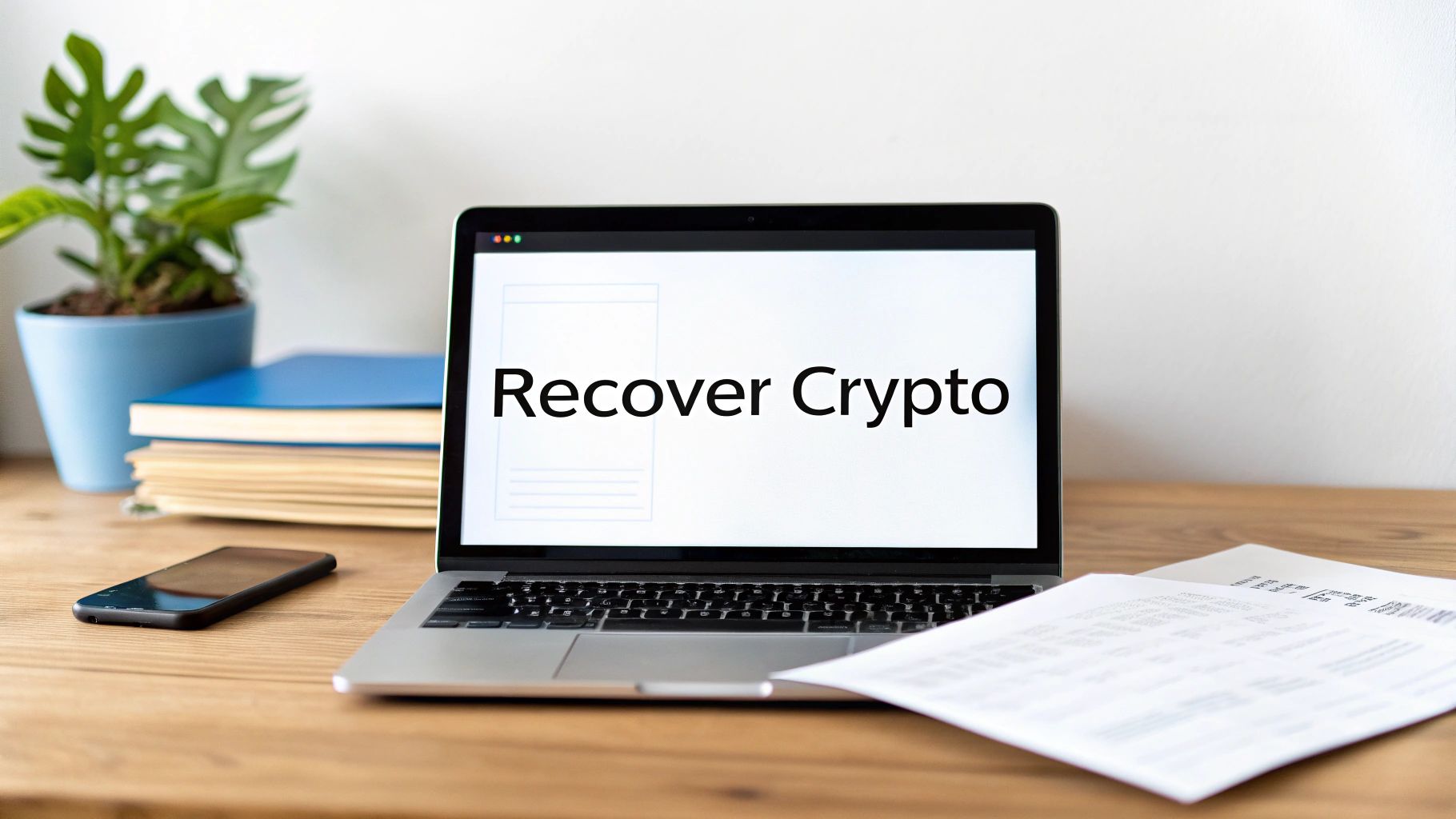That heart-stopping moment you realize you've sent crypto to the wrong address is something no one wants to experience. The hard truth is that blockchain transactions are, by design, almost always irreversible. Unlike a traditional bank transfer, there's no central authority to call up and cancel the payment.
But don't give in to the panic just yet. What you do next depends entirely on where those funds actually went.
Understanding the Finality of Crypto Transactions
The second it clicks that your crypto is gone, a wave of dread washes over you. It’s a gut-wrenching feeling that even seasoned crypto veterans know all too well. Before you do anything else, take a deep breath and remember the core principle of blockchain: immutability. Once a transaction is confirmed on the network, it’s set in stone.
This is the exact moment where costly mistakes can happen.

That "Panic Mode" is a real hurdle. It often leads to rushed decisions that can make a bad situation even worse. The key is to push past that initial shock and get logical about what just happened.
What Kind of Mistake Did You Make?
Not all address screw-ups are created equal. Figuring out your specific error is the first real step toward knowing if recovery is even a possibility. Your situation probably falls into one of these common buckets:
- A Typo Address: You fat-fingered a character, accidentally creating a valid-looking but non-existent address.
- A Cross-Chain Transfer: You sent one type of crypto to a wallet built for another—like sending Bitcoin (BTC) to an Ethereum (ETH) address.
- An Unknown Recipient: The address format is correct, but it belongs to a person or entity you don't know.
Each of these scenarios has a completely different outlook. A cross-chain transfer to a wallet you still control, for instance, sometimes has a recovery path. On the other hand, sending funds to a total stranger puts you at the mercy of their honesty.
The irreversible nature of transactions is a core feature, not a bug, of blockchain. It guarantees security and decentralization but places the full responsibility of accuracy on the user.
This finality is one of the biggest double-edged swords in crypto. It means sending funds to the wrong address usually results in a permanent loss unless the person on the other end decides to cooperate. The pseudonymous nature of wallet addresses makes tracking down the owner of an incorrect or fraudulent address exceptionally difficult. You can learn more about the current state of crypto security from recent analyses.
To quickly figure out what you're up against, let's break down the most common address mistakes and what they mean for your funds.
Assessing Your Situation: Common Address Mistakes
Use this table to quickly identify your error type and understand the immediate outlook for recovery.
| Type of Address Mistake | What This Means for Your Funds | Potential for Recovery |
|---|---|---|
| Simple Typo | You entered an address that looks valid but likely has no private key. The funds are "burned" and inaccessible to anyone. | Extremely Low to None. The funds are effectively lost forever. |
| Cross-Chain Transfer (to your own wallet) | You sent funds (e.g., BTC) to a wallet you own that supports a different chain (e.g., ETH). The funds are there but not visible. | Possible. Requires advanced techniques and depends on the wallet software (e.g., using your seed phrase to derive the correct private key). |
| Cross-Chain Transfer (to an exchange) | You sent funds to a centralized exchange's address for a different cryptocurrency. | Low but Possible. The exchange might have access to the private keys and could help, but they are not obligated to. Recovery often involves a significant fee. |
| Sent to a Stranger | The address is valid and belongs to another individual you don't know. | Very Low. Entirely dependent on the recipient's honesty and your ability to contact them (which is often impossible). |
| Sent to an Old or Incorrect Address You Own | You sent funds to a wallet address you previously used but no longer have access to. | Depends. If you have the seed phrase or private key for that old wallet, recovery is High. If not, it's None. |
Understanding which of these categories you fall into is absolutely crucial. If you sent crypto to a simple typo address, those funds are very likely gone—locked away in a digital vault nobody can open. But if those funds went to an address controlled by a known exchange, you might just have a small window of opportunity to act.
Your First 10 Minutes: An Emergency Action Plan
That gut-wrenching moment you realize you've sent crypto to the wrong address is a special kind of hell. Your first instinct is probably to panic, but what you do in the next few minutes is absolutely critical. While you can't hit an "undo" button, you can immediately start gathering the digital evidence you'll need for any shot at recovery.

Think of this as your emergency checklist. The goal is to document everything before the trail goes cold.
Immediately Locate Your Transaction ID
Every single crypto transaction creates a unique identifier, usually called a Transaction ID (TxID) or hash. This long string of letters and numbers is the official receipt of your transfer on the blockchain. Find it now. Go into your wallet's transaction history and copy it.
This TxID is everything. It's the primary key for investigating what just happened, and without it, you have no way to track the funds or even prove the transaction took place.
Once you have the TxID, your next stop is a block explorer. Think of it like a search engine for the blockchain. If you were dealing with Ethereum or an ERC-20 token, you'd use a service like Etherscan. For Bitcoin, something like Blockchain.com's explorer will do the trick.
Paste your TxID into the search bar. This will show you the transaction's live status. Is it still pending, or has it been confirmed? Once it's confirmed, that's the point of no return.
Key Takeaway: Documenting this is non-negotiable. Grab screenshots of your wallet, the block explorer page showing all the transaction details, and the incorrect address itself. This evidence is your most valuable asset if you need to contact an exchange or another third party.
Start Your Digital Paper Trail
With your info in hand, it's time to get organized. This isn't just about saving a few screenshots; you need to build a clear, chronological record of what went down. Trust me, a well-documented case is infinitely easier to explain if you need to ask for help.
Your documentation needs to include:
- The Transaction ID (TxID): Copy the full hash into a secure document.
- The Incorrect Recipient Address: The complete address you mistakenly sent the funds to.
- The Correct Recipient Address: The address where you actually meant to send the funds.
- The Amount and Type of Crypto: Be specific, like 0.5 ETH or 0.01 BTC.
- Timestamps: Note the exact date and time the transaction happened.
- Screenshots: Capture everything—your wallet's transaction history and the full block explorer page for that TxID.
I know this kind of meticulous record-keeping feels tedious when you're stressed, but it’s the most powerful action you can take right now. If the wrong address happens to belong to a centralized exchange, this documentation is the first thing their support team will ask for. Having it ready shows you're organized and serious, which can speed up their review process. Show up empty-handed, and your chances of getting help plummet.
How to Trace Your Transaction Like a Pro
Okay, take a deep breath. That initial gut-punch feeling is fading, and now it's time to put on your detective hat. You’ve already confirmed the transaction is on the blockchain, so let’s start digging into the details. This is more than just staring at a transaction hash; we're going to follow the digital breadcrumbs and figure out exactly where your crypto went.
Your number one tool for this job is a block explorer. Think of it as a public search engine for the blockchain. For anything on Ethereum, you'll be using Etherscan. For Bitcoin, something like Blockchain.com's explorer is perfect. These tools show you the entire life story of any wallet address, not just a simple "confirmed" status.
Analyzing the Recipient Address
Go ahead and copy the address you mistakenly sent funds to and paste it into the block explorer’s search bar. Now, don't just focus on your one transaction. We need to look at the address's entire history to find patterns and clues about who might be behind it.
As you start looking through the transaction list, ask yourself a few questions:
- Is this wallet even active? A wallet with thousands of transactions tells a very different story than one that only has your deposit in it.
- Where is it sending crypto? Look to see if it regularly sends funds to addresses that are publicly tagged as belonging to a major exchange like Binance, Coinbase, or Kraken.
- Where is it getting funds from? Is it receiving crypto from a ton of random sources, or just a few specific ones? This can help you tell a personal wallet from an exchange or service address.
This kind of on-chain analysis can give you some serious leads. For instance, if you see that the address consistently moves funds to a known exchange, there's a very good chance it's just a deposit address on that platform. Suddenly, you have a specific company you can contact.
A common mistake is seeing an unfamiliar address and just assuming it’s a dead end. Every transaction tells a story. An address that’s constantly interacting with DeFi protocols points to a savvy user, while one that only ever receives funds might be a "burn" address where crypto goes to die.
Ruling Out the Simple Stuff First
Before you jump to the worst-case scenario, let’s make sure this isn't a simple, silly mistake. It’s surprisingly easy for the "wrong" address to be one you actually own or have used before.
Carefully compare the incorrect address, character by character, against addresses you use all the time:
- Deposit addresses for your other exchange accounts.
- Addresses in your hardware or software wallets.
- Addresses of friends or family you've paid in the past.
Sometimes a copy-paste error grabs an old address from your clipboard history. Confirming the address doesn't belong to you or a close contact is a crucial step before you escalate things. Of course, if you think the funds were sent to a scammer, you’ll also need to understand the process to recover stolen cryptocurrency, as the strategy can change. This process of elimination helps you build a clear, accurate picture of what you’re dealing with.
Reaching Out and Avoiding Recovery Scams
Once you’ve done some on-chain detective work, you might have a better idea of who’s behind the address. If your sleuthing points to a major centralized exchange, you have a clear, if narrow, path forward. Making contact is the next logical move, but be warned: this is the exact moment you become a prime target for scammers.
When you send crypto to the wrong address, especially if it’s a big chunk of change, desperation has a way of clouding your judgment. Scammers absolutely thrive on this panic. They patrol forums and social media, just waiting for people in your exact situation, ready to dangle false hope in front of you for a fee.
Contacting an Exchange the Right Way
So, you’ve traced the address to a big name like Coinbase or Binance. Is there a chance of getting your crypto back? A very small one, yes. These companies technically control the private keys for all their deposit addresses, so they could help. But don't get your hopes too high—they have no obligation to, and even if they do, the process is painfully slow and often comes with a hefty fee.
If you’re going to try, you have to do it by the book:
- Use Official Channels Only: Go directly to the exchange’s official website and find their support or help center. Never, ever trust support links or phone numbers you find on Twitter, Telegram, or in a Google search. Scammers love to impersonate official support.
- Submit a Detailed Ticket: Lay out all the evidence you’ve gathered. Include the transaction ID (TxID), the wrong address you sent to, the correct address, the amount, and screenshots. A clear, well-documented request is far more likely to get a serious look.
- Be Patient and Persistent: It’s okay to follow up politely on your support ticket, but you have to understand that these requests are at the bottom of an exchange’s priority list. It could easily take weeks, or even months, to get a straight answer.
There’s also a more creative—though admittedly a huge long-shot—tactic you can try: the "dust" transaction. This involves sending a tiny amount of crypto (think $0.50 worth of BTC) to the same wrong address, but this time you embed a short message in the transaction data, something like, "Mistake, please email me at [your-email]." The odds of this working are slim, but it might be worth a shot if you suspect an individual, not an exchange, controls the wallet.
Spotting and Avoiding Recovery Scams
As soon as you start asking for help online, you'll almost certainly be swarmed by recovery "specialists" promising to retrieve your funds. The overwhelming majority of these people are scammers. The crypto world is full of predators, and this is one of their favorite hunting grounds.
In the first half of 2025 alone, crypto scams and hacks led to losses nearing $3.1 billion globally, highlighting the rapid acceleration of the problem. A primary factor behind these losses is users sending funds to wrong addresses due to scams or misinformation. You can discover more insights about these crypto crime trends.
Knowing the red flags is your best defense. Be extremely suspicious of anyone who:
- Guarantees recovery: It is flat-out impossible to guarantee the recovery of crypto sent to a wrong address. Anyone who tells you otherwise is lying to your face.
- Asks for an upfront fee: This is the classic scam. They'll ask for a "service fee," "tax," or "gas money" to start the recovery. As soon as you pay, they vanish.
- Requests your seed phrase or private keys: NEVER share this information. Ever. With anyone. Giving someone your seed phrase is like handing over the keys to your entire crypto vault.
- Claims they can "hack" the blockchain: That’s not how any of this works. Blockchain transactions are immutable. They can’t be reversed or hacked in the way these scammers imply.
Navigating this landscape is treacherous. If you've been a victim, understanding the nuances of a potential cryptocurrency scam recovery is critical to avoid getting burned a second time. While legitimate blockchain forensic firms do exist, they typically work with law enforcement on major cases, not individual mistakes. Your best protection is a healthy dose of skepticism. If it sounds too good to be true, it absolutely is.
Look, sending crypto to the wrong address is a gut-wrenching lesson. It’s one of those mistakes you only make once. But the most important thing you can do after a mess like that is to make damn sure it never happens again.
While getting your funds back is a long shot, prevention is 100% in your hands. This isn't just about "double-checking the address." We need to build a smarter, more robust set of habits that act as your personal firewall for every single transaction.

Think of these practices as fundamental operating procedures for anyone serious about crypto. They shift you from being a passive user to an active defender of your own assets.
Make Test Transactions a Hard Rule
Before you ever send a significant amount of crypto, you send a test transaction first. No exceptions. Think of it as a mandatory dress rehearsal for the main event.
Send a tiny, almost worthless amount—like $1 worth of ETH or a few satoshis of Bitcoin—to the recipient's address. Then, you wait. You don't do anything else until the recipient confirms on their end that they've received it.
Only then do you proceed with the real transfer. This single habit alone wipes out nearly every common mistake, from simple copy-paste fails to sending funds to the wrong blockchain network. It’s a tiny bit of friction that can save you from a catastrophic loss.
Use Your Exchange's Security Tools
Centralized exchanges have some powerful, and often ignored, security features designed to prevent exactly these kinds of blunders. The most effective one is address whitelisting.
When you turn this on, your account is only allowed to withdraw funds to addresses you've already pre-approved. Adding a new address usually triggers a 24-hour waiting period, which is a brilliant "cooling-off" buffer. It stops you from making a rash mistake and blocks potential hackers dead in their tracks.
- How it works: You add a trusted address (like your hardware wallet) to an approved list.
- The benefit: Any attempt to withdraw to an unknown address is automatically rejected.
- Why it's crucial: This simple toggle makes it virtually impossible to accidentally send your life savings to a random, incorrect address from your exchange account.
Ditch Bad Habits and Upgrade Your Methods
Relying on manually copying and pasting an address is like walking a tightrope without a net. It’s 2024. Clipboard-hijacking malware is a real and terrifying threat that can silently swap the address you copied with a scammer's. It's time to adopt safer methods.
Using QR codes is a huge step up from manual copying. It eliminates typos and clipboard malware. But the real gold standard for making transactions simple and secure is a blockchain naming service.
Services like the Ethereum Name Service (ENS) let you swap out a long, nightmarish string of characters for a simple, human-readable name like "yourname.eth". Instead of triple-checking a 42-character string, you just type in a name you can remember. This slashes the chance of human error.
Finally, if you’re holding any serious amount of crypto, get a hardware wallet. Something like a Ledger or a Trezor. These devices keep your private keys completely offline, safe from hackers. More importantly, they force you to physically verify the recipient's address on the device's screen before you can confirm the transaction. It's one last, critical line of defense against sending your crypto into the void.
Common Questions After a Mistaken Crypto Transaction
That sinking feeling after hitting "send" and realizing your crypto is headed to the wrong address is usually followed by a frantic rush of questions. Let's cut through the noise and get you some straight answers to the most common concerns.
Can a Confirmed Crypto Transaction Be Reversed?
The short answer is no. Once a transaction gets confirmed on the network and added to the blockchain, it's set in stone. This immutability is one of the core principles of blockchain technology.
Think of it this way: there's no central bank or credit card company to call and dispute the charge. The system is designed to be decentralized, which means no single entity can undo a transaction. The only way to get your funds back is if the person on the other end is honest enough to send them back.
What Happens If I Sent Coins to an Address That Doesn't Exist?
This is a nightmare scenario for many, and unfortunately, the outcome isn't great. If you send crypto to a syntactically correct address that no one actually owns—maybe from a simple typo—those funds are effectively gone forever.
The coins aren't technically destroyed. They're just sitting in a digital wallet that no one has the keys to, making them completely inaccessible. In the crypto world, this is often called "burning" the coins, as they're permanently removed from the circulating supply.
The Hard Truth: Blockchain's finality puts the responsibility squarely on you, the user. While this creates a trustless and secure system, it also means that mistakes can be costly and permanent.
Are Crypto Recovery Services Legit?
You need to tread very carefully here. The crypto space is full of scammers looking to take advantage of people in a desperate situation. The truth is, the vast majority of services claiming they can "guaranteed" recover your funds are flat-out scams.
- Red Flags: Watch out for anyone asking for an upfront fee, promising to "hack" a wallet, or demanding your private keys or seed phrase. Never share these.
- Real Experts: Legitimate blockchain forensic firms do exist, but they're not for the average user. They typically work with law enforcement on massive hacks and fraud cases, not individual transaction errors.
Rule of thumb: if an offer to help lands in your DMs unsolicited, assume it's a scam.
I Sent Funds to the Wrong Network. What Can I Do?
Sending funds to the wrong blockchain (like an Ethereum token to a Bitcoin address) is a surprisingly common mistake. Whether you can get them back really boils down to one thing: who controls the destination wallet.
If you sent the funds to a wallet where you control the keys, like MetaMask or Trust Wallet, there's a good chance you can recover them. The process usually involves using your seed phrase to access the same wallet address on the correct network.
But if you sent the crypto to a wallet controlled by a centralized exchange (like Coinbase or Binance), your only option is to contact their support team immediately. Recovery isn't guaranteed and depends entirely on their internal policies and whether they have the technical ability to help.
If your issue is losing access to a wallet because of a forgotten password or other technical problems, Wallet Recovery AI uses specialized, AI-driven methods to help you get back in. You can learn more and start the recovery process securely at https://walletrecovery.ai.


Leave a Reply